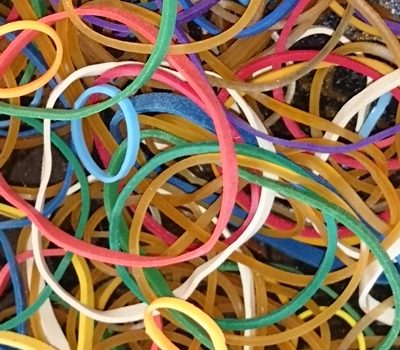Energy is a great subject in science. It covers so many things and I have many other aspects that I hope to share with you soon but one thing that explains energy so well is a simple rubber band; it can demonstrate elasticity, kinetic energy and potential energy and it great to use in some really cool experiments. Here are just a few short facts on the topic.
What is Elasticity?
Elasticity is the ability of an object to return to its original size and shape after it has been stretched or squeezed.

When we pull an elastic object we are applying a force on it called a stress. If we apply too much stress to an object it will eventually reach a limit called its elastic limit.
When an object is pulled beyond its elastic limit is cannot return to its original shape.
All objects will eventually lose their elasticity due to wear and tear, friction and stress.
Potential and Kinetic Energy
Potential energy is energy stored within something. Kinetic energy is energy in motion.
If we take the example of stretching a rubber band…

When we use force to stretch an elastic object, such as an elastic band we are filling it with potential energy. When we let go of the rubber band and it springs back to its original shape, the energy released is Kinetic Energy.
Did you know… kangaroos and other animals use the combination of potential and kinetic energy to save energy while jumping and springing?
Rubber
Rubber is a material that has very good elasticity. It is a polymer, made up of a long chain of repeating molecules, that can be easily stretched and bent.
Rubber exists in both a natural and synthetic form; the natural form is latex from the sap of rubber trees.
A bit of history
The ancient Aztec and Mayan civilisations are thought to have been the first to discover and use this natural rubber. They used it to make balls for sport and rubber shoes, although the quality of this rubber was sensitive to heat and cold.
Columbus is credited with bringing rubber to Europe.
In 1839 Charles Goodyear discovered that he could stabilise rubber by mixing it with sulphur at high pressure; he called this process vulcanisation.
When Goodyear died in 1860 he was completely impoverished due to constant legal costs regarding his rubber patents.
Did you know… the largest rubber band ball ever made weighed 4,097kg and was made using 700,000 rubber bands?
An experiment to try
Want to try an experiment that combines rubber, elasticity and kinetic and potential energy? Why not make a catapult? Or use elasticity to launch a paper plane. You’ll find out how, and a lot more of the science behind these experiments in this post!

**********
A new venture
This article originally appeared in Science Spin magazine. Although the magazine is no longer in print I am delighted to be sharing some science facts and experiments in a new venture… you’ll find my new SCIENCE FOR KIDS page in each edition of Easy Parenting Magazine. I share one of our favourite experiments in the April/May edition, currently in shops. Take a look…


